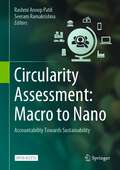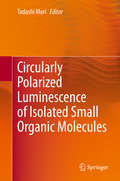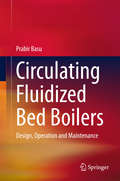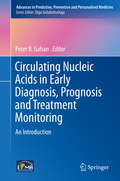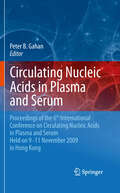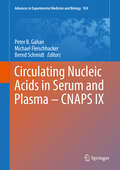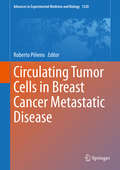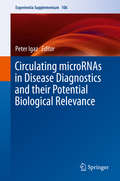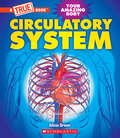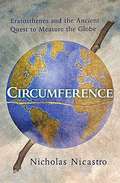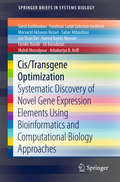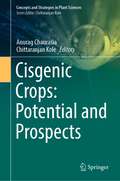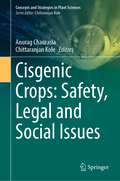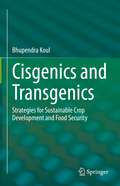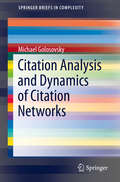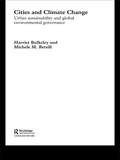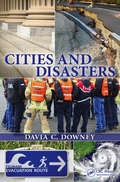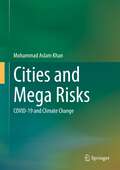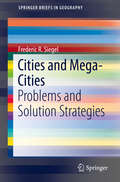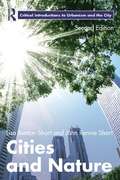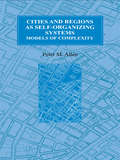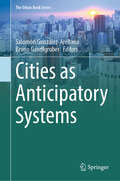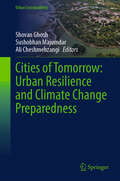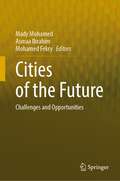- Table View
- List View
Circularity Assessment: Accountability Towards Sustainability
by Seeram Ramakrishna Rashmi Anoop PatilThis open access book attempts to provide a perspective on the circularity assessment at different levels of the systemic hierarchy and advocates better resource management for a sustainable future. It demonstrates how relevant circularity indicators are used for quantifying the extent of circularity of each level. Illustrative case studies that discuss the process of quantitatively interpreting progress towards circularity are provided. This work caters to a broad readership inclusive of governance, basic research, engineering, and business stakeholders. The conclusion signifies the role of consumer community in achieving circularity.
Circularly Polarized Luminescence of Isolated Small Organic Molecules
by Tadashi MoriThis book collects all the latest advances in the leading research of the circularly polarized luminescence (CPL) of small organic molecules. Compared with that of lanthanide-based fluorophores, the research into the CPL of small organic molecules is still at the developmental stage for their relatively smaller dissymmetric factors, but has been a source of widespread attention recently. The book includes the state of the art of the discoveries in CPL organic molecules, such as helicenes, biaryls, cyclophanes, boron dipyrromethene dyes, and other chiral molecules, mostly in their isolated states, covering all possible chiral substances for future applications. This book also highlights the recent development of CPL instruments as well as time-resolved circular dichroism spectroscopy, to facilitate the further development and future design of CPL molecules.
Circulating Fluidized Bed Boilers: Design, Operation and Maintenance
by Prabir Basu· Explains operation and scientific fundamentals of circulating fluidized bed (CFB) boilers · Outlines practical issues in industrial use · Teaches how to optimize design for maximum reliability and efficiency · Discusses operating and maintenance issues and how to troubleshoot them This book provides practicing engineers and students with insight into the design and operation of circulating fluidized bed (CFB) boilers through a combination of theoretical concepts and practical experience. An emphasis on combustion, hydrodynamics, heat transfer, and material issues illustrates these concepts with numerous examples from actual operating plants. The relevance of design and feed-stock parameters to the operation of a CFB boiler are also examined, along with their impacts on designs of mechanical components, including cyclones, air distributor grids, and solid recycle systems. This versatile resource explains how fluidized bed equipment works and how the basic principles of thermodynamics and fluid mechanics influence design, while providing insight into planning new projects, troubleshooting existing equipment, and appreciating the capabilities and limitations of the process. From hydrodynamics to construction and maintenance, the author covers all of the essential information needed to understand, design, operate, and maintain a complete fluidized bed system. It is a must for clean coal technology as well as for biomass power generation.
Circulating Nucleic Acids in Early Diagnosis, Prognosis and Treatment Monitoring: An Introduction (Advances in Predictive, Preventive and Personalised Medicine #5)
by Peter B. GahanDNA and RNA fractions can be isolated from a variety of body fluids including whole blood, serum, plasma, urine, saliva and cerebrospinal fluid from both patients and healthy individuals. Such isolates can be exploited in the early detection of clinical disorders, stratification of patients for treatment, treatment monitoring and clinical follow-up In addition, the use in fetal medicine allows the early detection of fetal sex, Rh factor and aneuploid disorders as well as following both fetal and premature born infant development. This volume is intended as a primer for those who are interested in entering the field of circulating nucleic acids. The areas covered in this volume include: · Background and general biology of circulating nucleic acids · Methodology · Applications of circulating nucleic acids · Quality Assurance · Ethics
Circulating Nucleic Acids in Plasma and Serum: Proceedings of the 6th international conference on circulating nucleic acids in plasma and serum held on 9-11 November 2009 in Hong Kong.
by Peter B. GahanDNA and RNA fractions have been isolated from the whole blood, serum, plasma, the surface of blood cells, urine, saliva and spinal fluid from both healthy individuals and clinical patients. Recent developments are presented concerning the isolation, quantification and analysis of these molecules and their use in the identification of specific nucleic acid fragments related to a variety of clinical disorders thereby permitting their early diagnosis and prognosis.
Circulating Nucleic Acids in Serum and Plasma – CNAPS IX (Advances in Experimental Medicine and Biology #924)
by Bernd Schmidt Peter B. Gahan Michael FleischhackerThe book will present the progress made since the last meeting in fall 2013 concerning the analysis of circulating extra-cellular nucleic acids. There are a modest number of laboratories involved in this field, nevertheless the number of papers published by researchers is extensive. The articles which will be published in this meeting report will be a valuable contribution for researchers and research students alike and will help them to stay on top of the developments in different research areas and to ,,cross borders" between them.
Circulating Tumor Cells in Breast Cancer Metastatic Disease (Advances in Experimental Medicine and Biology #1220)
by Roberto PiñeiroThis book is aimed to summarise the key aspects of the role of circulating tumour cells (CTCs) in breast cancer, with special attention to their contribution to tumour progression and establishment of metastatic disease. We aim to give a clear overview of the knowledge about CTCs, framed in the context of breast cancer, by analysing basic and clinical research carried out so far. In a broader sense, we will address what are the main clinical needs of this disease based on its molecular heterogeneity (subtypes) and lay out the knowledge and understanding that CTCs are giving about it and how they are contributing and can still improve the better monitoring and management of breast cancer patients. We will discuss the evidences of the use of CTCs as a tool to monitor cancer progression and therapy response, based on the prognostic and predictive value they have, as well as a tool to unravel mechanisms of resistance to therapy and to identify new biomarkers allowing to predict therapy success. Moreover, we will analyse the main aspects of ongoing clinical trials and how they can contribute to determine the clinical utility of CTCs as a breast cancer biomarker. We will also touch upon general knowledge or basic notions of the biology of the metastatic process in epithelial cancers, in order to understand the origin and biology of CTCs. In this sense, we will pay special attention to EMT (epithelial to mesenchymal transition), dormancy and minimal residual disease, three key aspects that determine the outcome of the disease. We will also cover general aspects on the isolation and characterization techniques applies to the study of CTCs, and also the possibilities that the study of CTCs, as a biomarker with biological function, is opening in terms of understanding the biology of metastatic cells and the identification of therapeutic targets based on the functional and molecular characterization of CTCs. Lastly, we will try to foresee the future of CTCs in terms of clinical application and implementation in the clinical routine.
Circulating microRNAs in Disease Diagnostics and their Potential Biological Relevance (Experientia Supplementum #106)
by Peter IgazMicroRNAs as the endogenous mediators of RNA interference have experienced an unprecedented career in recent years, highlighting their pathogenic, diagnostic and potential therapeutic relevance. Beside tissue microRNAs, they are also found in body fluids, most notably in blood. Significant differences of circulating microRNA levels have been found in various diseases, making them candidates for minimally invasive markers of disease, for example tumor malignancy. The book focuses on the potential diagnostic applicability of circulating microRNAs in various diseases and their potential biological significance.
Circulatory System (A True Book (Relaunch))
by Alicia GreenDiscover the main systems of our amazing human body with this new series of books!The blood that flows through your body constantly brings food and oxygen to your muscles, organs, and bones and carries away waste. And it is all powered by that magnificent muscle, your heart. Did you know that your heart beats about 100,000 times a day? Or that the blood in your body travels a total of 12,000 miles daily? That's more than four times the width of the United States from coast to coast! Learn all this and more in Circulatory System.ABOUT THE SERIES:The human body is a complex ⹀ and remarkable ⹀ machine. Digesting our food. Pumping our blood. Walking, running, and dancing. It takes our many body systems working together to keep us alive and living our lives to the fullest. This set of A True Books offers an in-depth look at our amazing bodies ⹀ one system at a time. Interesting information is presented in a fun, friendly way ⹀ and in the simplest terms possible ⹀ giving students a "behind-the-scenes" look at how their bodies work.
Circumference: Eratosthenes and the Ancient Quest to Measure the Globe
by Nicholas NicastroHow do you measure the size of the planet you're standing on? "Circumference" is the story of what happened when one man asked himself that very question. Nicholas Nicastro brings to life one of history's greatest experiments when an ancient Greek named Eratosthenes first accurately determined the distance around the spherical earth. In this fascinating narrative history, Nicastro takes a look at a deceptively simple but stunning achievement made by one man, millennia ago, with only the simplest of materials at his disposal. How was he able to measure the land at a time when distance was more a matter of a shrug and a guess at the time spent on a donkey's back? How could he be so confident in the assumptions that underlay his calculations: that the earth was round and the sun so far away that its rays struck the ground in parallel lines? Was it luck or pure scientific genius? Nicastro brings readers on a trip into a long-vanished world that prefigured modernity in many ways, where neither Eratosthenes' reputation, nor the validity of his method, nor his leadership of the Great Library of Alexandria were enough to convince all his contemporaries about the dimensions of the earth. Eratosthenes' results were debated for centuries until he was ultimately vindicated almost 2000 years later, during the great voyages of exploration. "Circumference" is a compelling scientific detective story that transports readers back to a time when humans had no idea how big their world was--and the fate of a man who dared to measure the incomprehensible. [This text is listed as an example that meets Common Core Standards in English language arts in grades 9-10 at http://www.corestandards.org.]
Cis/Transgene Optimization: Systematic Discovery Of Novel Gene Expression Elements Using Bioinformatics And Computational Biology Approaches (Springerbriefs In Systems Biology Ser.)
by Saeid Kadkhodaei Farahnaz Sadat Golestan Hashemi Morvarid Akhavan Rezaei Sahar Abbasiliasi Joo Shun Tan Hamid Rajabi Memari Faruku Bande Ali Baradaran Mahdi Moradpour Arbakariya B. AriffThis book is a practical review which focuses on computational analysis and on in silico approaches towards the systematic discovery of various key functional gene expression elements in microalgae as a model. So far, in this regard very little information is available. Efficient stepwise procedures for analysing the matrix attachment regions (MARs) are outlined, as well as for translation initiation sites (TIS), signal peptide (SP) sequences, gene optimization and transformation systems. These outlines can be efficiently deployed as practical models for the systematic discovery of key expression elements and for the optimization of cis/transgenes in other micro/organisms. The first chapter is an introduction on the key gene expression elements analysed in this book, including scaffold/matrix attachment regions, translation initiation sites, signal peptides as well as gene optimization. Chapter 2 focuses on systematic strategies and computational approaches toward in silico analysis of each factor. The analyses outcomes is assessed individually in chapter 3 followed by developing the specific conceptual models for each element in Chapter 4. The concluding remarks are discussed in Chapter 5. This work is of interest to computational and experimental biologists interested in transcriptional regulation analysis as well as to researchers and scientists who wish to consider the use of bioinformatics and computational biology in design, analysis, or regulatory reviews of key gene expression elements for the production of recombinant proteins experiments.
Cisgenic Crops: Potential and Prospects (Concepts and Strategies in Plant Sciences)
by Chittaranjan Kole Anurag ChaurasiaThis book is the first attempt for in-depth compilation of current knowledge on cisgenic crops and their potential prospects as a sustainable substitute for the controversial genetically modified crops. Innovative methodologies for the development of cisgenic crops for disease resistance, improved nutritional contents, suitability for organic farming, survival under climate change, and their role in conservation of plant genetic resources have been highlighted. Combined with molecular markers and genome editing, an advanced approach for crop improvement is reported. The book has 14 chapters authored by globally leading experts on the subject. This book is useful to the students, teachers, researchers and policy planners working across the disciplines of classical plant breeding up to the recent genetically modified and genome edited crops.
Cisgenic Crops: Safety, Legal and Social Issues (Concepts and Strategies in Plant Sciences)
by Chittaranjan Kole Anurag ChaurasiaThis book is the first comprehensive compilation of existing knowledge on the impact of cisgenic crops on biodiversity, environment, and ecosystem. Strategies to create and access cisgenic crops, potential risks assessment, and legal implications across the globe (European Union, North and South Americas, Africa, and Asia) are enumerated. Ethics, economics, safety, social concerns, and consumer acceptance of cisgenic foods are deliberated. Policy paradigm and ways to overcome GM regulations through cisgenic crops are highlighted. The book has 12 chapters authored by internationally leading experts on the subject. This book will be useful especially for the policy makers and GMO regulators, while the students, teachers, and researchers from across the globe will be equally benefited.
Cisgenics and Transgenics: Strategies for Sustainable Crop Development and Food Security
by Bhupendra KoulThis book presents up-to-date information on various vector-less/direct (physical, chemical) and vector-mediated/indirect (Agrobacterium-mediated) plant transformation techniques. It summarizes various strategies that facilitate a gene from lower organism to be expressed in higher plants and also in silico designing of synthetic gene for higher expression. It also highlights the importance of strong promoters to drive the expression of transgene(s). This book encompasses the advantages and drawbacks of cisgenesis and transgenesis, their implications towards sustainable crop improvement, and their future prospects. The importance, limitations, challenges, recent developments, and future prospects of molecular pharming is also discussed. The book concludes with a chapter that summarizes the major contribution of GM-crops towards global food security and economy, advances in genome editing for crop improvement, challenges and risk associated with the release of GM-crops, and the future of GM technology. This book is meant for students and researchers in the field of life sciences, food science, and agriculture.
Citation Analysis and Dynamics of Citation Networks (SpringerBriefs in Complexity)
by Michael GolosovskyThis book deals with the science of science by applying network science methods to citation networks and uniquely presents a physics-inspired model of citation dynamics. This stochastic model of citation dynamics is based on a well-known copying or recursive search mechanism. The measurements covered in this text yield parameters of the model and reveal that citation dynamics of scientific papers is not linear, as was previously assumed. This nonlinearity has far-reaching consequences including non-stationary citation distributions, diverging citation trajectories of similar papers, and runaways or "immortal papers" with an infinite citation lifespan. The author shows us that nonlinear stochastic models of citation dynamics can be the basis for a quantitative probabilistic prediction of citation dynamics of individual papers and of the overall journal impact factor. This book appeals to students and researchers from differing subject areas working in network science and bibliometrics.
Cities In Space (Endless Frontier Volume #3)
by Jerry Pournelle John F. CarrSomeday in the near future, our pioneer spirit will take us to the stars. But how will we organize our colonies? What unforeseen dangers will we face? And who will be chosen to go? Now today's masters of science fiction offer some startling possibilities. Introduction: The endless frontier by Jerry Pournelle Consort by Jerry Pournelle The Free Agent by Michael Cassutt What are these Lagrange points anyway by Doug Beason The Christmas Count by Henry Melton The Lagrange League Stationary Habitats by William John Watkins When Silver Plums Fall by Bruce Boston High Flight by John Gillespie MaGee Jr. Lifeguard by Doug Beason New Worlds in Space by Norman Spinrad The Software Plague by John Park Blindsight by Robert Silverberg Access to Space, SSX by Jim Ransom Ghost Town by Chad Oliver Poppa Was a Catcher by Steven Gould In appreciation Robert A. Heinlein by Jerry Pournelle The Long Watch by Robert A. Heinlein
Cities and Climate Change (Routledge Studies in Physical Geography and Environment)
by Harriet Bulkeley Michelle BetsillClimate change is one of the most challenging issues of our time. As key sites in the production and management of emissions of greenhouse gases, cities will be crucial for the implementation of international agreements and national policies on climate change. This book provides a critical analysis of the role of cities in addressing climate change and the prospects for urban sustainability. Cities and Climate Change is the first in-depth analysis of the role of cities in addressing climate change. The book argues that key challenges concerning the resources and powers of local government, as well as conflicts between local goals for economic development and climate change mitigation, have restricted the level of local action on climate change. These findings have significant implications for the prospects of mitigating climate change and achieving urban sustainability. This book provides a valuable interdisciplinary analysis of these issues, and will appeal to students and researchers interested in sustainability at local and global scales.
Cities and Disasters
by Davia C. DowneyCities and Disasters presents interdisciplinary and multinational perspectives on emergency management policy, economic development, and the various factors that affect the recovery process after natural disasters strike urban areas. The book has three central themes: policy, urbanity, and the interplay of events after disasters that affect the pro
Cities and Mega Risks: COVID-19 and Climate Change
by Mohammad Aslam KhanThis book focuses on the emergence of COVID-19 and climate change as twin mega risks to cities of both developed and developing countries. The work analyses how the pandemic has transformed city functions, promoted remote working, and affected socializing, education and learning patterns, recreation, as well as shopping and entertainment. It discusses the lessons learned from these two Mega Risks, the evolution of urban patterns and functions in their wake, and provides visionary thinking for the improvement of cities from the experiences gained. The COVID-19 Pandemic and climate change are both posing serious threats to cities’ future. Together, they demand changes in the ways cities’ function and operate. The work presents a case for a better understanding of the twin mega risks, the magnitude of their impacts, the responses of cities in combating these issues, and planning strategies for preparing, mitigating and adapting to these and future risks. The book is designed to provide reliable resource materials for a wide audience such as planners, professional practitioners, scientists, students, teachers and researchers working in various fields including geography, environmental sciences, social sciences, policy and planning.
Cities and Mega-Cities: Problems and Solution Strategies (SpringerBriefs in Geography)
by Frederic R. SiegelThis book discusses existing and future global problems of physical, chemical, biological and societal origins faced by increasingly populated cities and mega-cities, and options to mitigate or eliminate them. In nine chapters, the book focuses on rehabilitation and redevelopment projects aimed at converting shantytowns/slums into well serviced neighborhoods via secure housing, clean piped water, adequate access to sanitation, and other amenities for good living conditions. Examples of rehabilitation (restore capacity, structures, efficiency) and redevelopment (redesign, rebuild, attract investment) are addressed in detail, as are the sources of major financing to support such projects and proposals. The final chapters also discuss problems faced by countries with contracting populations, and their viable solutions. The book will be of interest to academics, city planners, land-use planners, NGOs, and designers /architects specializing in urban development and redevelopment.
Cities and Nature (Routledge Critical Introductions to Urbanism and the City)
by John Rennie Short Lisa Benton-ShortCities and Nature connects environmental processes with social and political actions. The book reconnects science and social science to demonstrate how the city is part of the environment and how it is subject to environmental constraints and opportunities. This second edition has been extensively revised and updated with in-depth examination of theory and critical themes. Greater discussion is given to urbanization trends and megacities; the post-industrial city and global economic changes; developing cities and slums; urban political ecology; the role of the city in climate change; and sustainability. The book explores the historical relationship between cities and nature, contemporary challenges to this relationship, and attempts taken to create more sustainable cities. The historical context situates urban development and its impact on the environment, and in turn the environmental impact on people in cities. This provides a foundation from which to understand contemporary issues, such as urban political ecology, hazards and disasters, water quality and supply, air pollution and climate change. The book then considers sustainability and how it has been informed by different theoretical approaches. Issues of environmental justice and the role of gender and race are explored. The final chapter examines the ways in which cities are practicing sustainability, from light "greening" efforts such as planting trees, to more comprehensive sustainability plans that integrate the multiple dimensions of sustainability. The text contains case studies from around the globe, with many drawn from cities in the developing world, as well as reviews of recent research, updated and expanded further reading to highlight relevant films, websites and journal articles. This book is an asset to students and researchers in geography, environmental studies, urban studies and planning and sustainability.
Cities and Regions as Self-Organizing Systems: Models of Complexity (Environmental Problems And Social Dynamics Ser. #Vol. 1)
by Peter M. AllenA clear methodological and philosophical introduction to complexity theory as applied to urban and regional systems is given, together with a detailed series of modelling case studies compiled over the last couple of decades. Based on the new complex systems thinking, mathematical models are developed which attempt to simulate the evolution of towns, cities, and regions and the complicated co-evolutionary interaction there is both between and within them. The aim of these models is to help policy analysis and decision-making in urban and regional planning, energy policy, transport policy, and many other areas of service provision, infrastructure planning, and investment that are necessary for a successful society.
Cities as Anticipatory Systems (The Urban Book Series)
by Bruno Gandlgruber Salomón González-ArellanoThe theory of anticipation suggests that systems, both biological and social, can adapt and update based on predictive models. Cities, which can be seen as complex systems that are associated with innovation, are undergoing changes in response to current socio-ecological transitions. Therefore, cities can be viewed as anticipatory systems that may signal future transformations that arise in response to the challenges posed by these ongoing socio-ecological transitions. This book combines futures studies and anticipation theories with urban studies and theories of urban transition. Chapters address theoretical and empirical aspects of both fields and present case studies from a wide array of international perspectives. These diverse examples demonstrate how cities implement arrangements and strategies to allow their actors of all kinds to anticipate change. As such, contributions in this edited volume explore possible scenarios and proposals for strengthening anticipatory competences in urban areas and examine the potential consequences of these innovations in the cities of the future.
Cities of Tomorrow: Urban Resilience and Climate Change Preparedness (Urban Sustainability)
by Ali Cheshmehzangi Sushobhan Majumdar Shovan GhoshThis book takes a comprehensive and forward-looking approach to urban resilience and climate change preparedness. It combines theoretical insights, practical case studies and innovative strategies to address the complex challenges cities face in an era of rapid urbanisation and changing climate patterns. It presents a fresh and innovative approach to addressing the intertwined challenges of urban resilience and climate change preparedness. What sets this book apart is its emphasis on forward-looking strategies, multidisciplinary insights and a comprehensive exploration of cutting-edge technologies and collaborative approaches. This book is likely to be diverse, encompassing professionals, academics, researchers, policymakers, practitioners, students and individuals interested in the fields of urban planning, environmental science, sustainability, climate change adaptation and related disciplines. The book aims to appeal to both experts in the field and those new to the subject, providing a valuable resource for different audiences.
Cities of the Future: Challenges and Opportunities
by Asmaa Ibrahim Mady Mohamed Mohamed FekryThis book seeks to address the key challenges and opportunities of "future cities" embracing novel approaches and grounded technologies in pursuing a vision for smart, inclusive cities. The objective of this book is to discuss multiple areas at the local, national, and international levels and how these challenges can hinder the development objectives planned to be achieved by the cities of the future. The chapters featured in this collection were presented at the 6th Memaryat International Conference (MIC 2022), held at the Effat University, Jeddah. MIC’s objective is to build bridges between science, technology, and innovation, seen as the key levers of attaining the SDGs.This book provides the most innovative ideas presented at the conference to address the key manifestation of “future cities" to embrace novel approaches and grounded technologies in the pursue of a vision for smart inclusive cities. It thus represents a platform for diverse contributions from academics and practitioners to present their different perspectives addressed theoretically as well as in practice concerning the challenges and opportunities of future cities. This includes contributions from decision-makers, architects, urban planners, urban designers, entrepreneurs, and educators to stimulate discussion covering the latest on the challenges and opportunities for better future cities in the different domains of architecture, building science and technology, environmental design, mobility & infrastructure, urban design & landscape, housing & real estate developments, urban planning, governance, socio-cultural & economic development, community engagement, tourism and heritage revitalization.
